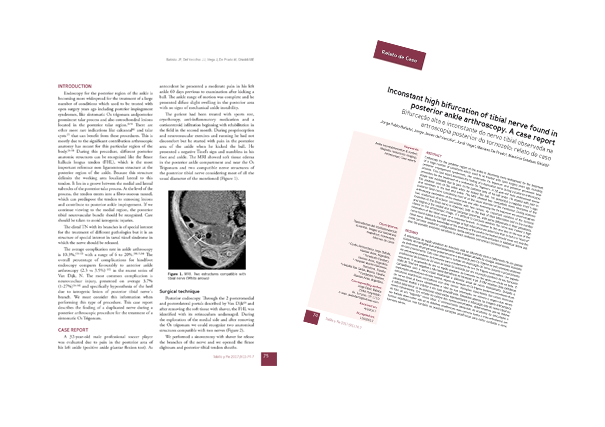Jorge Pablo Batista1, Jorge Javier del Vecchio2, Jordi Vega 3, Mariano De Prado4, Mauricio Esteban Ghioldi5.
1 Centro Artroscópico Jorge Batista, Buenos Aires, Argentina.
2 Fundación Favaloro, Buenos Aires, Argentina.
3 Hospital Quirón Barcelona, Barcelona, España.
4 Hospital San Carlos, Murcia, España.
5 Fundación Favaloro, Buenos Aires, Argentina.

Abstract
Endoscopy for the posterior region of the ankle is becoming more widespread for the treatment of a large number of conditions which used to be treated with open surgery years ago including posterior impingement syndromes, like sintomatic Os trigonum and posterior prominent talar process. This case report describes the finding of a duplicated nerve during a posterior arthroscopic procedure for the treatment of a sintomatic Os Trigonum. A 32-year-old male professional soccer player was evaluated due to pain in the posterior area of his left ankle. He started with pain in the posterior area of the ankle when he kicked the ball. He presented a negative Tinel´s sign and numbless in his foot and ankle. The MRI showed two compatible nerve structures of the posterior tibial nerve considering most of all the usual diameter of the mentioned. During posterior arthroscopy exploration of the medial side and after removing the Os trigonum we could recognize two anatomical structures compatible with two nerves. An important variation of the terminal branches of the tibial nerve is observed, both in the level of their bifurcation and in the number and origins of the medial and lower calcaneal branches, with some differences in their prevalence. Based on the arthroscopic image, it´s difficult to conclude whether the nerve was indeed a high bifurcation of the tibial nerve or a calcaneal branch. In relation to this and due to the size of the nerve found added to the high percentage of high bifurcation we determine that in fact is a “second” tibial nerve. Adequate knowledge of the anatomy of the joint to be treated should cover not only the most common anatomic configurations (extra-articular and intra-articular) in statistical terms but also the possible anatomic variations to avoid confusion and serious technical errors.Keywords
Ankle injuries/prevention & control; Magnetic ressonance imaging; Arthroscopy; Case reports.
Resumen
La endoscopia para la región posterior del tobillo se está generalizando para el tratamiento de una gran cantidad de afecciones que solían tratarse con cirugía abierta hace años, incluidos los síndromes de compresión posterior, como el Os trigonum sintomático y el proceso posterior del astrágalo prominente. Este informe de caso describe el hallazgo de un nervio duplicado durante un procedimiento artroscópico posterior para el tratamiento de un Os Trigonum sintomático. Se evaluó a un jugador de fútbol profesional masculino de 32 años debido a un dolor en el área posterior de su tobillo izquierdo. Comenzó con dolor en el área posterior del tobillo cuando golpeó la pelota. Presentó un signo negativo de Tinel y su pié y tobillo quedaron inmóviles. La resonancia magnética mostró dos estructuras nerviosas compatibles del nervio tibial posterior teniendo en cuenta la mayor parte del diámetro habitual de los mencionados. Durante la exploración artroscópica posterior del lado medial y después de extraer el Os trigonum, pudimos reconocer dos estructuras anatómicas compatibles con dos nervios. Se observa una variación importante de las ramas terminales del nervio tibial, tanto en el nivel de su bifurcación como en el número y origen de las ramas medial e inferior del calcáneo, con algunas diferencias en su prevalencia. Con base en la imagen artroscópica, es difícil concluir si el nervio fue de hecho una alta bifurcación del nervio tibial o una rama del calcáneo. En relación con esto y debido al tamaño del nervio encontrado sumado al alto porcentaje de alta bifurcación, determinamos que de hecho es un "segundo" nervio tibial. El conocimiento adecuado de la anatomía de la articulación a tratar debe abarcar no solo las configuraciones anatómicas más comunes (extraarticulares e intraarticulares) en términos estadísticos, sino también las posibles variaciones anatómicas para evitar confusiones y graves errores técnicos.
Keywords
Lesiones en el tobillo / prevención y control; Imagen de resonancia magnética; Artroscopia; Reportes del caso.